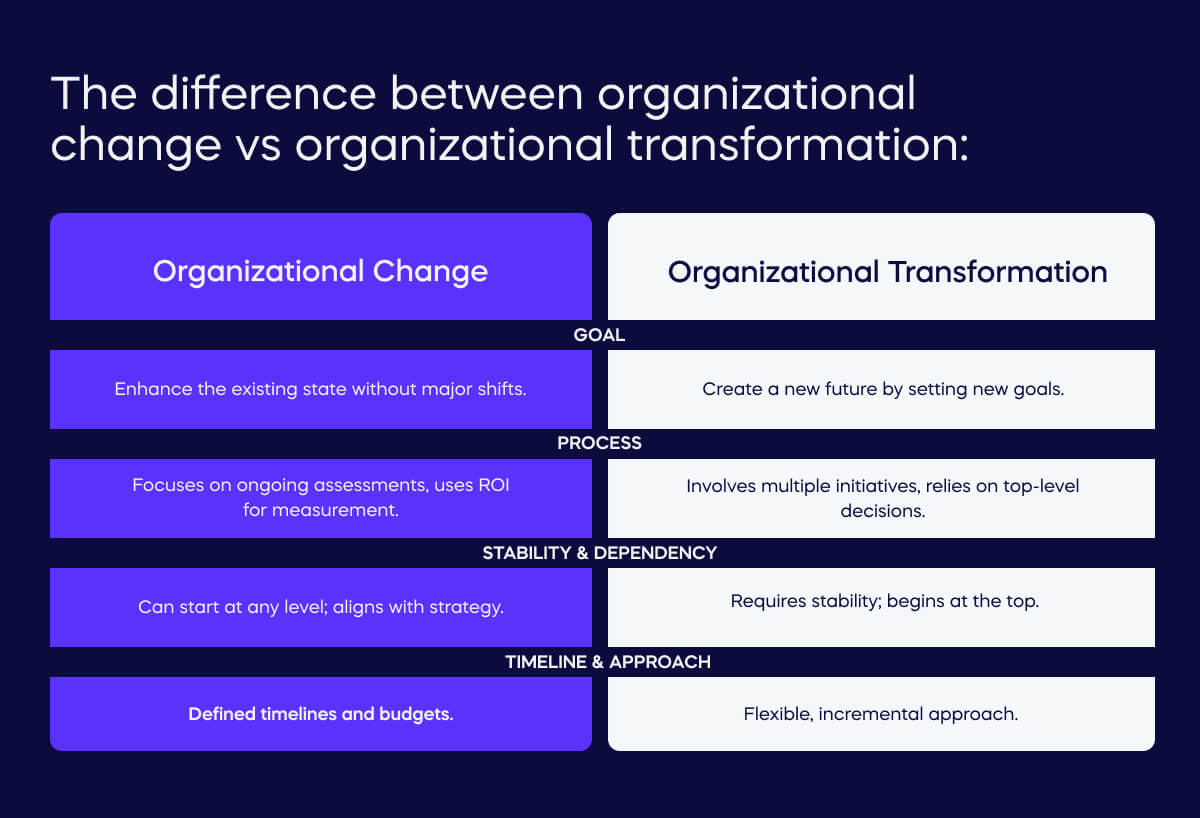The world continues to change at an unprecedented rate. There have been challenges like pandemics, recessions, and wars in recent years. Leaders can no longer issue orders and expect employees to follow them without pushback.
To stay competitive and survive, you need to increase business agility. Organizational transformation is key to this process. It involves making widespread changes in how employees behave.
But, employees are often skeptical of business transformation. Communication about these changes can also be ineffective.
In this guide, you will learn what organizational transformation involves. You will also learn the main steps to achieve it and why it is important. Additionally, we will explain how organizational transformation differs from simple organizational change.
What is an organizational transformation?
Organizational transformation involves making major changes to a company’s structure, operations, and culture to meet future goals. This process aims to improve the company’s efficiency and effectiveness.
As technology and business conditions evolve, companies need to rethink their operations. Many senior leaders focus on cultural changes to keep their organizations competitive and successful.
Organizing transformation has several important aspects. First, changing processes and workflows means streamlining operations. It also means introducing new technologies to increase employee productivity.
Next, transforming company culture involves influencing employee behavior and attitudes. This can impact the organization’s success. Then, digital business transformation requires staying current with the latest technology. It aims to enhance customer experience, manage data better, and improve operational efficiency.
11 steps to successfully implement an organizational transformation within your business
Here are the steps that you need to take to achieve a successful organizational transformation:
Know what you want to achieve
To successfully transform an organization, the first essential step is to have a clear vision, purpose, and goals.
HR managers need to communicate these elements to both employees and leaders. When everyone understands the ‘why’ behind the change, gaining their support is easier.
Adopt a holistic approach to manage the workplace transformation. This ensures a comprehensive process and an effective operating model.
For instance, if your goal is to improve processes and enhance agility and collaboration, assess the impact on your organizational structure. Additionally, consider the effects on technology and potential talent gaps. This ensures that all areas align with the transformation goals.
Choose a structured approach to transformation
Organizational transformation can follow several approaches, each with its own focus and methodology.
The Core Process Redesign (CPR) approach involves revamping how people, activities, and information are connected. The goal is to achieve major improvements in cost, quality, and time.
Instead of relying on traditional hierarchical structures, CPR shifts to horizontal workflows. This approach spans functions and locations. It aims for dramatic, simultaneous gains in performance metrics.
Alternatively, the waterfall method systematically evaluates organizational structures and processes. Leaders collaborate to review and adjust structures, such as those organized by region or product.
They analyze different options and expect potential problems, which helps in addressing any objections. The goal is for leaders to commit to the chosen plan, even if it’s not their preferred option, which ensures a unified front.
The agile methodology takes a more flexible approach. It forms cross-functional squads to lead change initiatives. These teams tackle challenges by experimenting with new solutions and learning from their experiences.
They receive ongoing coaching and training to refine their methods. Successful strategies are then scaled across the organization. The focus is on creating a playbook to sustain these practices over time.
Ensure that there is a shared ownership of the transformation among employees

Developing a clear vision for future success is key to transforming an organization. Employees need to understand why change is necessary and grasp why challenging the current way of doing things is important. A strong reason for the change helps them tackle the challenges that will arise during the transformation.
When leaders share a clear vision, employees are more likely to support the change. If employees don’t understand the need for transformation, achieving success becomes difficult.
It’s not about telling people what will happen. It’s about creating a sense of shared ownership. Leaders should guide the team on what they need to do. You want your teams to embrace the new way of working the organization aims to adopt together.
Develop an organizational transformation plan
Plan the steps needed to transform the organization. Start with the results in mind. Work backward through all areas of the organization. Create an organizational transformation plan with a timeline to make the transformation process more tangible. This helps maintain focus.
For example, if you want to use technology to improve your learning culture, your timelined plan should include several steps. Begin with preliminary research of existing systems. Then, arrange demos with vendors. Select and buy the right tool. Implement it, and onboard your employees to use it.
Additionally, a digital adoption tool can enhance the employee onboarding process. This tool offers personalized guidance and walkthroughs for each employee, helping them achieve their part in the transformation.
Communicate the benefits of the new and the challenges of the status quo
As a leader, recognizing that the status quo is unsustainable is one of the first steps in any organizational transformation. This takes courage and the ability to facilitate emotionally uncomfortable conversations. These conversations help you accept the gap between where you are today and where you need to be tomorrow.
Start by working on yourself. Become aware of the mindsets and assumptions that underpin your view of success. Once you understand and appreciate this, communicate it to your employees. Help your employees understand why this change can impact their lives.
Connect them to a purpose that transcends their roles and status. For example, you don’t just sell cosmetics if you are a cosmetics company. Instead, you could show employees that the business strives to improve people’s lives every day.
You help them feel happier and more confident. This way, employees can see that an organizational transformation can improve their lives and improve their future potential. This will encourage them to come to work daily with a great attitude and a growth mindset.
Your employees also need to understand that while the status quo may be comfortable, it won’t help the company create value in the future. Explain why change is necessary and show how it aligns with a greater purpose. This will motivate everyone to embrace the transformation.
Focus on active listening throughout the gradual transformation process
Organizational transformation can be both exciting and unsettling for employees. They might feel enthusiastic about being part of a purposeful company. But they might also be anxious if they can’t see how their skills will remain relevant.
Addressing these emotions is crucial. Bringing up topics like anxiety, fear of the unknown, and different ideas about the organization’s future in formal conversations helps resolve them.
Soft skills like active listening are as important as having a project plan.
Leaders can improve this skill by encouraging emotional awareness. By asking simple questions, they can create a space for emotional awareness and expression. For example, they could ask an employee how they are feeling and why they feel that way. They could also allow silence and open questions to let people explore their emotions.
Next, practice deep listening. Use deep listening techniques to hear what is said and unsaid. Use paraphrasing tools to paraphrase what you think you’ve heard to help with emotional regulation. Encourage self-observation and self-compassion. Focus on breathwork and create an environment free from judgment.
Then, facilitate reflection. Create workshops for employees to reflect on their emotions. This creates conversations that focus on developing new narratives to explain current situations.
Consider implementing an organizational transformation in stages
Changing everything at once is impossible. Focus on the key matters you want to tackle first. Remember, the transformation plan might change during the process. If it does, re-evaluate, change the plan, and don’t hesitate to reprioritize.
For instance, test a new process or tool with a select group of managers first. Create an employee feedback loop with this initial group. This will help them, and you understand how the transformation fits within their existing goals and the wider organization. Use this feedback to improve your implementation plan. Create further testing cycles if needed before the major rollout.
Understand whether leadership also supports this transformation
Many people believe a leader’s primary role is to focus outward and guide others. But, to lead their workforce through a transformation, leaders must first examine their own relationship with change. If leaders are unwilling to change themselves, they cannot expect to drive change within the organization.
You need to help them focus on leadership development. This involves becoming more aware of their emotions. It also considers learning to handle the discomfort that comes with personal growth. Leaders must recognize and address their fears before they can help their employees navigate change.
Before starting any transformation, reflect on how attitudes and behaviors have contributed to the current situation. Acknowledging their role in any existing problems is crucial for creating a positive shift.
In essence, leaders must overcome their own fears and biases to support their employees better. They need to model the change they want to see in their organization. By doing so, they can improve their own readiness for change. They also create a more supportive environment for their employees to embrace new challenges.
Appreciate that the transformation will be different for all employees

Understand that employees will each have their own reactions to the transformation. Some may struggle, while others adapt well. Create an environment where small failures are acceptable.
If employees fear making mistakes, they might miss out on opportunities. Make sure employees know that failures won’t affect their careers or pay.
Employers should also provide the emotional support employees need. This ensures that when things get tough, employees feel motivated. They should be energized by the challenge rather than overwhelmed.
So, encourage employees to express their honest concerns without fearing negative consequences. Without trust and psychological safety, getting employees on board with changes is hard. If employees fear the transformation and can’t voice their problems, the process will likely fail.
Recognize that introducing new systems or technology will trigger various emotions. These include stress about learning new tools and fears about job security or disruptions. View technology as a means to achieve your goals. Focus on training to help employees effectively use the new tools and create value.
Measure, reward, and share success
Use data to track progress. Gather feedback from employees and customers. Keep track of how the change is working over time. Choose metrics that align with your goals. Define success clearly before starting the project. Set specific objectives and outline the organizational benefits.
Establish a regular schedule to track progress. Monitor KPIs throughout the project. Analyze the results and adjust as needed. For example, measure how quickly people adopt a new system. Track the number of users at go-live, ten days after, and 30 days after. Also, track the time it takes employees to understand and put these new skills into practice during and after training.
If some individuals excel, compare their performance after implementation. Reward their success with incentives.
Continue building on the innovative nature of an organizational transformation in the future
You need to make organizational transformation a constant part of your company. It is not a one-time event. This means setting up an entrepreneurial culture where change and improvement happen often.
Provide employees with the information and resources they need to grow and innovate. This might include encouraging cross-training so everyone can learn new skills, regardless of their team. It also makes it easy for employees to access tools and training online. Employees should also be able to share their feedback and help prepare for future challenges.
Why is organizational transformation important?
Organizational transformation is crucial because it impacts a company’s performance. As businesses grow and change, they can assess their current state and plan strategically for the future.
This transformation leverages employees’ collective skills to achieve shared goals. It also boosts efficiency and fosters a positive company culture that aligns with core values. Employees who see their work connected to these values feel more engaged and are also more likely to stay with the company.
Companies can also gain a competitive advantage by transforming the organization. Embracing change and adapting to market needs allows companies to stay ahead and create a lasting influence in their industry.
What is the difference between organizational change vs organizational transformation?

Organizational transformation and organizational change have different goals and processes.
Organizational change focuses on improving the current state by comparing it to the past. It involves ongoing assessments and often uses ROI to measure success. Proper documentation is crucial to avoid failure. The aim is to enhance the existing state without major structural shifts.
However, organizational transformation aims to create a new future by assessing the present and setting future goals. It starts at the top levels of an organization and relies on a stable current state to succeed. Unlike change, which is project-specific, transformation involves many initiatives and seeks a fundamental shift.
The main differences are their origins, stability requirements, dependencies, and planning methods. Transformation generally starts at the highest level and requires stability.
Change can begin at any level but must align with strategy. Change has defined timelines and budgets. Transformation needs a flexible, incremental approach, focusing on long-term goals.
Drive a lasting organizational transformation within your organization
An organizational transformation is always challenging. It can create stress, even when the program is going well. The challenge is to keep your team motivated. Turn that stress into positive energy. Avoid letting it lead to negativity and poor performance.
Successful leaders work closely with their employees. They address and manage emotions rather than ignoring them. The best leaders create a clear vision for the organization and a safe environment where everyone can collaborate and share their thoughts.
Respect for employees at all levels is crucial. Understand their feelings. Consider how the business transformation will make their jobs easier.
When a transformation succeeds, it builds confidence and readiness for future changes. Given the fast pace of change in today’s world, you need to prepare for ongoing transformations.

